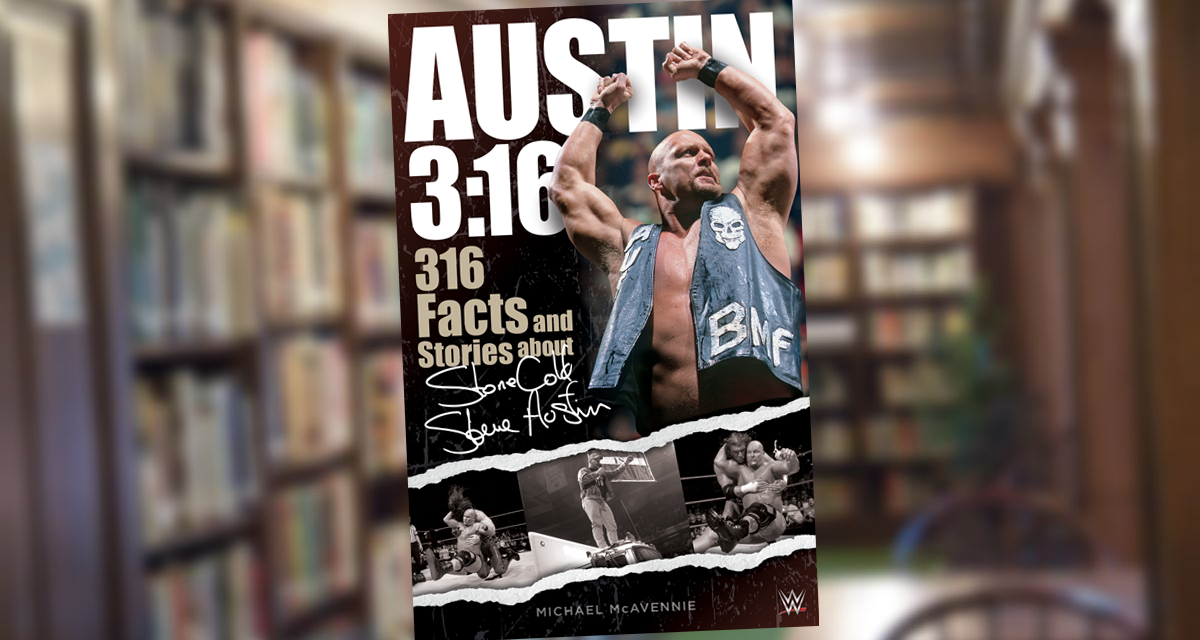Who could forget the beer bash?
Or the boss’ car filled with cement?
How about the time he impersonated a doctor and hit said boss with a bed pan?
Or when he launched both a catch phrase and best-selling t-shirt by putting his own twist on a Bible verse after becoming King of the Ring?
Stone Cold Steve Austin has given pro wrestling fans plenty of memorable moments throughout his career in the squared circle. Now you can relive these milestones and more in Michael McAvennie’s latest book, Austin 3:16: 316 Facts and Stories About Stone Cold Steve Austin, out now from ECW Press.
In a phone interview with SlamWrestling.net, McAvennie, 54, talked about being an author, his time working at both World Wrestling Entertainment (WWE) and DC Comics, surviving a Bob Backlund chicken wing and of course all things Stone Cold Steve Austin!
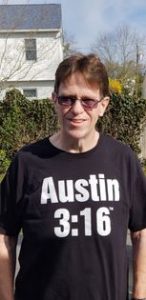
Michael McAvennie modeling his favorite t-shirt!
SlamWrestling.net: Have you always been a wrestling fan? What drew you to pro wrestling?
McAvennie: Yeah, I would say I’ve been a fan of wrestling since I was four or five years of age. And that would have been my mother and father who got me into it. When I was that young, we didn’t have a lot of TV programs for wrestling. But it was usually on Saturdays. It would either be like an 11 a.m. show, or it would be a midnight show. And I wasn’t a very good sleeper as a kid. I’m still not a good sleeper. But yeah, my family would circle around and we’d watch Superstars of Wrestling and other various programs when available. And then as I got a little older, I started looking around other channels. There were several Spanish language channels, that would have wrestling. And I would watch that and just try to figure out what they were saying as we were going along. And that would include, you know, WWF (World Wrestling Federation, now WWE) product back then. And also wrestling from Florida with Gordon Solie. So yeah, so I grew up with it. And, you know, pretty extensively, and strangely enough, I think if I did have any kind of a lapse, it would have been during the Rock ‘n’ Wrestling era. You know, I would watch it on occasion. But I was also in college. So I was kind of really busy all the time.
Slam: Who is your favorite wrestler and why?
McAvennie: It’s changed a number of times over the years. My first favorite wrestler was Bruno Sammartino. And that was because I just liked him. I also grew up as a comic book fan. And to me, he was sort of like, wrestling’s answer of a superhero. Back then, he was always straight laced, a good guy, and always did the right thing. That kind of mentality. He had a lot of honor, in anything he did in the ring. And he was really skilled. You know, I found that his technical prowess was better than a lot of the guys I would see. And what I liked about him was that he was genuine. He wasn’t like the evil supervillain type, like a Baron von Raschke. Or the over the top type of personality. He was who he was. And he came off as somebody who was a lot like what he was in real life. I always liked that. And I think that’s why also, my next favorite guy was Bob Backlund. A lot of the same reasons, very clean cut. But I also thought he was a tremendous wrestler. And even though he was very, very strong and very skilled, he always came off as an underdog against a lot of opponents, at least early in his career. And I liked that he always overcame the odds against him.
Slam: What did you study in university and what has your career path been like?
McAvennie: Sure, I studied journalism at St. John’s University in Queens, New York. I graduated in 1989. And it was one of those things where I thought I was going to study to be a news reporter. But I wasn’t as into news reporting, as I was with regards to the entertainment industry. I was even a features editor on my school newspaper. And I found that to be more entertaining because it was a little lighter, but we could still also weigh in with interviews and report things as if it were straightforward news. Again, I felt it gave me more variety to work with. So yeah, I studied that and then my first job out of college, I was an assistant editor at Videography magazine, which was very different than anything I’d been doing as a student at that point. I don’t even know if it’s in existence at this point. But it was a magazine dedicated to professional videography, equipment and videographers because at the time it was a booming industry. It was rapidly growing. So I would report on that from conventions or latest techniques, technological advancements, and things like that for the television and film industry. And I just did that for a few years. And then I got back into entertainment and was a managing editor at Starlog for several years. That was a magazine dedicated to science fiction, adventure, superheroes, fantasy, and slight horror because we also worked with Fangoria magazine, which was the big horror magazine back in the day.
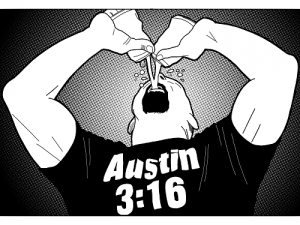
Stone Cold Steve Austin celebrates the only way he knows how by double fisting two beers! Illustration by Anthony Ruttgaizer. According to McAvennie’s research, Austin often drank Natural Light beer in the ring.
Slam: Fangoria??? I’m very jealous! (At this point in the interview, this writer/horror fanatic will admit she totally marked out!)
McAvennie: I was a contributing editor for them as well, because we were all in the same office. And under the same company. So yeah, I did that for several years. And I was a freelancer for them for about 10, 11 or 12 years. So yeah, I had a great time with that. And the editor there, Dave McDonald, he was really a mentor. For me, he taught me a lot about being an editor, about what to look for, finding the hook in a story and trying to make sure that we always found the most entertaining aspect of an interview.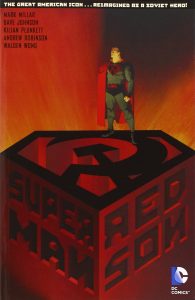
And then after that, I moved to DC Comics. I was an assistant editor there, and then I became a full editor. And I did that for 10 years, managed several Superman related titles. And was the editor of a book called Superman: Red Son, which was an animated feature last year. And was also editor for characters like the Legion of Superheroes, Supergirl, Superboy, Steel all these other types of characters. So that was a great time. And it was doing something that I grew up loving as well. It went from a hobby to a job. But you know, it was a dream that I had realized. And I always enjoyed my time there.
After that, I did some freelancing for a while, for about five years. And I would do projects for WWE as a freelance writer and an editor, mostly writing at that point. I wrote a few books for them, including The World Wrestling Entertainment Yearbook 2003 Edition and Divas Uncovered, which is basically more of a picture book with quotes peppered throughout it. It was one of those things where it looked nice, but I wanted it to be a little more substantive. And it just didn’t work out that way. It was kind of more cheesecake. And Signature Moves: The Finishing Moves of Sport Entertainment Superstars, which was another photo book, but dedicated to each superstars’ finisher or signature move and kind of explained what it was or showed what it was.
I edited several WWE related books as well. And then I actually got a call from them back in 2006, to do some freelancing for their website. Well, first for the magazine, I did that for about two months. And then I did it for the website. I was told that it was only going to be a three month gig. And then about a month into it they asked if I’d stay on because they liked what I wrote. They liked the way I edited and they thought I’d be a good influence for a lot of the other digital team members because a lot of them were very young, and I was already more of a seasoned writer and editor at that point. So I did that. And what was originally a three month gig turned out to be a 12 year job. I went from managing the domestic team on the digital side over to the international teams and we launched international websites for WWE starting around 2014. And we opened sites for Germany, Middle East, Latin America, France. I’m sure I’m forgetting a few we had. We also worked on China and Japan’s websites and we also developed their social media platforms as well.
Slam: So when you were editor at DC Comics, did you focus on the writing or did you do some illustrating as well?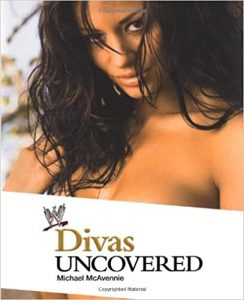
McAvennie: (Laughs) Oh, no, I can’t draw to save my life! I’ve worked with really, really big name artists. And I remember one of them I actually worked with he had drawn something on the page and it looked nice, but it looked a little off. And I tried to explain it to him, that it didn’t work very well. And at the time, I think there was a little bit of a language barrier because he was from France. And I didn’t think I was explaining myself properly. So I drew him something really quick and faxed it over to him. And then he called me back and he said, “Okay, Mike, I see what you’re trying to tell me. And that’s great. I’ll do it. But you have to promise me you will never draw again!” I said, “I can make that promise. That’s not a problem.” My stick figures are even bad! So yeah, I was an editor. Basically, I would put teams together. And by that I mean I would gather a team of writers and artists. In terms of artists, it would be a penciler, usually a different guy who would be an inker. Then we’d also put together colorists and letterers as well. And I’d work out a schedule for everybody to have their deliverables. And essentially, we’d put together monthly books, and I did about six monthly books at a time. Usually. It’s gotten heavier now from what I understand. But back then at the time, that was a big deal, usually you were looking at trying to get four monthly books going. So I had six and had that for a couple of years.
It was a great experience. It was doing something that I loved, where I actually felt like I could help craft the stories in a different way. I wasn’t necessarily writing though, I have written some comics as well, not as much as I’ve edited. But I always liked the collaborative process and making sure that whatever we were giving readers was something that they would be entertained by. And I felt that if it didn’t entertain me, I didn’t think it was going to entertain a lot of people. And that sounds egotistical. And I don’t mean it that way. I just wanted to try and make sure that whatever people were trying to produce for me as an editor, if I didn’t get it, I worried that my readers wouldn’t get it either. So I wanted to make sure that they got the best experience possible out of it.
Slam: OK, I’m going to put you on the spot here. Who is your favorite comic book character?
McAvennie: Whoo, that’s a tough one. You know, I worked on the Superman titles when I was at DC, but I grew up as a Batman fan. He was my first superhero crush. In terms of reading comics, my first comic was a Superboy comic. I was a little over two years old, and I just liked the way it looked. So I picked it up Superboy, issue 140, still have it to this day. It holds a special place in my heart.
Slam: And you also wrote the Batmobile Owner’s Manual?
McAvennie: That’s correct. I wrote that. That was around 2008, I believe. And in 2010, I also was one of the co-writers for DC Comics Year by Year. I wrote the entries for the 1960s and 1970s. And it was split up between four writers.
Slam: Did you get to see an actual Batmobile to work on that book? Please tell me you at least got to take one for a test drive!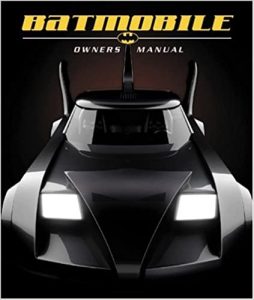
McAvennie: I wish I could have. I didn’t get that luxury. I kind of just had to make it up in my head based off of illustrations and diagrams that the designers were doing because a lot of the DK Books (the book’s publisher) are very visually heavy. And usually the copy is incorporated in to accommodate the sizing of the graphics and everything. And that’s fine as long as I knew that going in, it makes perfect sense. So that worked out.
What was interesting was, I didn’t know a thing about cars! I still don’t! I’m lucky I know where the engine is in a car. But it’s one of those things where I just researched it and made sure that however, I was presenting any of my facts that… yeah, it’s a Batmobile. So some of the facts are going to be ludicrous. But I want there to be some some kernel of truth in there. And I think that’s what wrestling is too, you know, especially WWE prefers to make sure we always refer to it as sports entertainment. Yes, there is some fabrication to it, but there’s a lot of truth going on in it too. And it blurs the line when it’s done, right. If it blurs the line successfully, you think, ‘Hey, is that supposed to have happened? Was that guy supposed to take a hit like that?’ And when you’re not sure, then they’ve done their job well.
Slam: So you said you were with WWE for 12 years, why are you no longer with them?
McAvennie: Yeah, I left in 2019. I live on Long Island and I was spending my last few years working in the New York City office. So it was an easier commute. But before that I had done about nine years driving back and forth up to Connecticut every day. And that was about 135 miles round trip every day. And in rush hour in New York, we’re looking at the better part of four to five hours travel per day.
Ultimately (the commute) was a big factor into it. I knew there was some reorganization going on in the company too or at least in my department. And I saw that they wanted us to start coming back up to the Connecticut office. I wasn’t seeing my son (who is seven years old) as much too, because I was always working late. So I was just like this might be the best time for me to try and do something different.
Slam: I promise we will get to the Austin book next, but I read you survived a Bob Backlund chicken wing! You must tell us about that!
McAvennie: Many years ago, I worked in the offices in Connecticut with Howard Finkel for a time. He was part of our team for about, I think, five years. And Howard would every once in a while bring over one of the WWE legends or superstars and take them for a tour around the offices. And Howard knew that I was a Bob Backlund fan growing up. So he had Mr. Backlund with him one day, and he introduced me to him. And I was just like, wow this is amazing! And I’m not the type who usually marks out I guess you would say. I try to be professional and try not to seem giddy or overwhelmed, because that can be a turn off when you’re trying to meet people in a professional setting. But you know, you could tell I was very, very enthusiastic to meet him. I was really happy about it and chatting with them a bit. And I forgot how it came up. There was a mention about the chicken wing. And the next thing I know Bob Backlund comes up around behind me and he puts me in the chicken wing and shows me it and I was like smiling and at the same time I’m also thinking to myself, holy crap, this actually does hurt! He was pulling and I was feeling the pain a little bit from it. But I wasn’t gonna say, “Hey I tap” or anything because this is great. I’m getting a chicken wing from Bob Backlund! That was a highlight!
Slam: So where did the idea for the Austin book come from?
McAvennie: I spoke with Steve Pantaleo over at WWE. He is the guy who oversees the production and publication through other licensers and whatnot. And Steve (Pantaleo) had approached me about working on a book about Stone Cold Steve Austin. We talked about it a bit. And the idea was in honor of Austin 3:16 day, we would play up 316 facts and stories about Stone Cold Steve Austin, and have it come out on March 16.
It was a great opportunity for me. They knew I was a Stone Cold fan as well. He was another guy that I liked a lot. He and The Rock were two guys that I thought were tremendous back in the Attitude Era. And I thought this was great opportunity for me to work on something on a character that I thought so much of.
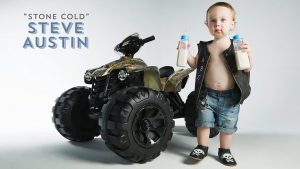
Years before he wrote the Austin book and during his time at WWE, McAvennie volunteered his son, Cillian, to be the Texas Rattlesnake during the WWE’s Superstar Babies photo shoot. Photo courtesy of McAvennie.
Slam: Why did you go the trivia book route and not a straight up bio?
McAvennie: Well, when we discussed the idea, the idea was never to actually go with a full straight out bio. And we didn’t necessarily want to do it as a trivia book, either. We really just wanted to have snippets of facts. And Austin 3:16 is is one of those things that there are a number of people out there that don’t necessarily know the whole story about Stone Cold Steve Austin, but they know about Austin 3:16. Because back in the late 1990s, you could be a casual fan and still know who The Rock and Stone Cold were. You didn’t have to be well versed in sports entertainment trivia to follow them. And it was kind of like with Hulk Hogan as well. Hulk Hogan was in every medium on the planet at one point, back in the 1980s. And it really wasn’t a matter of sports entertainment getting out to other brands, it was about a lot of other brands coming over and integrating with sports entertainment. And that’s kind of what happened, I think, with Stone Cold and the Rock back in the late 1990s. So when we talked about doing this project, I thought it was a good way to just go and collect some facts that your average sports entertainment fan might not know, but might be interested in. But it would also appeal to the diehards as well, especially if they found a few of the facts that we provided to be things that they didn’t know. At least in my case, I didn’t want to just give them something that rehashed something they saw on TV already.
Slam: Have you ever met Steve Austin?
McAvennie: I’ve never met him directly. No, not in person.
Slam: Did you get to talk to him for this book?
McAvennie: No, I didn’t. WWE would talk with him about it. This is the type of project where there wasn’t a lot of lead time to develop either. (McAvennie says he started writing the book in July of 2020 and was finished by the end of September.) It was something that we came up with in the middle of last year (2020). And so it had to be a quick turnaround on it too. But everything I wrote and produced was researched heavily. And I also made sure I was contacting people that I knew I could get a hold of easily. And that would be people like WWE’s archivist (Benjamin Brown). Or speaking with WWE personnel because I still had a number of contacts there from my days working there. Or if I had some questions for Steve (Austin) directly, Steve Pantaleo would come back to me with information if I needed to know it.
Slam: How much freedom were you given with this project?
McAvennie: To the WWE’s credit, I was given a ton of freedom, actually, I was surprised. And I don’t mean that as like a slight at WWE. It’s about any company that you work with especially a good company, a good solid company, they’re very protective of the brand. And they’re very, very particular about how the brand is presented to its audience. And I respect that, because having worked for that brand for 12 years, I already had the style guide. I already had knowledge about what would be a good thing to use, and what were things that we probably should avoid bringing up. So I think that it helped that they knew that they had somebody who was reliable, and knew that I was not the type of person who was going to make a ton of wrestling jargon mistakes that they would have to spend most of their days and nights fixing. So a lot of credit goes to Steve Pantaleo and Michael Holmes (Executive Editor at ECW Press) on that as well. I made sure that I asked questions upfront with them, to confirm if that was a good direction to go or a direction to avoid with regards to verbiage or certain events that happened in WWE history, things like that. So I went in knowing where I could venture and where I should tread carefully. And that made it a lot easier for me to have a lot of creative freedom.
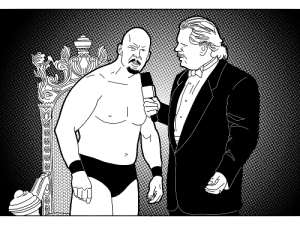
Austin delivers his infamous “Austin 3:16” speech to Dok Hendrix (Michael P.S. Hayes) after winning the 1996 King of the Ring tournament. Illustration by Anthony Ruttgaizer.
Slam: And for research, you mentioned that you had access to the WWE archive, tell me more about the research process for this book.
McAvennie: For research I would talk to their archivist, Ben Brown. And just as an example, I said I knew from a long time ago that Stone Cold had had been given several names by WWE management to see if anything might work with him because to his credit, Steve (Austin) knew that The Ringmaster just didn’t work as an idea. It wasn’t working for him. It may have been a good idea for someone else, or a good persona for someone else. But that just wasn’t his persona. And so Stone Cold didn’t have any ideas at that point as to what he should call himself. He knew the type of character he wanted to be. But when he pitched them the character, management came back to him with a ton of names that that are in the book, and I’ll let you and the readers decide what you thought of them. (See pages 14 and 15 in the book for the less than stellar ideas including Bitter Von Ruthless, Cool Luke and Fang Frost among other chilly gems!)
It was not a good list. And so Ben made sure that I had the list from the actual documents so that anything I published from it was 100 per cent accurate. There was nothing for me to speculate on. It wasn’t something I found on Wikipedia or something, so those little elements like that. Another thing would be the kind of beer that Stone Cold often drank in the ring. A lot of people always thought it was Bud Light or Coors Light, and it’s actually Natural Light. And that was something I was having a hard time researching and making sure of, but when I reached out to the archivist at WWE, he had contacted Mark Yeaton, the guy who used to throw the beers to Stone Cold. And Mark confirmed that it was Natural Light that Stone Cold would drink in the ring most of the time.
Slam: Were there any facts that you were surprised to learn or stood out to you?
McAvennie: You know there were a number of them. I think I was surprised as I was going for more of the statistical stuff with regards to not so much how many times Austin won the Royal Rumble match because that’s pretty easy. That’s three times. But an example of how many times did he actually finish in the final four of his Royal Rumble appearances. But from from what I remember, he finished in the final four in all of them, except for his first one. And that was because in the first one he was supposed to finish in the final four, but he fell out of the ring.
Slam: Because of baby oil, right?
McAvennie: Yeah, the baby oil on the ring rope. He flipped right out. And he was supposed to go toe-to-toe with with Shawn Michaels toward the conclusion of the match. And he basically had to say to Michaels from the outside, “Hey, we got to change it, got to change it up.” So the little things like that, that’s where I was kind of surprised, because I didn’t expect it. It wasn’t until I fully researched it where I just noticed little tidbits like that where it was like he (Austin) was an ongoing presence all the time there. So I thought that was kind of cool. Other little things that I thought were really interesting was finding out that when Austin wanted to have the Austin 3:16 t-shirt, management actually wanted to do something different. They wanted to do “cause Stone Cold said so” as his first t shirt. And they changed their mind the first night on RAW after King of the Ring, because everybody had Austin 3:16 signs up. They were crude, man made or fan made signs, but I think they got the point and realized Austin 3:16 is something that they’re (the fans) are clicking with. And that’s where we’ll go with it.
Slam: What is your favorite Steve Austin moment?
McAvennie: Wow! All right. That’s another one. I got to think about here. I mean, I do have a number of them. I loved the Austin 3:16 promo. I know that sounds a little bit of a cheap way out of answering this, but it’s it’s the truth. I mean, at that moment, when he gave that promo, I watched it live and I was surprised. He came off as a guy who really didn’t have anything planned to say ahead of time, but the words just came out of his mouth naturally. And I think that’s where he turned a corner as a character or a persona. It was something that really defined him. What I think worked about him in that moment was that he’s not the kind of guy I necessarily wanted to be like because he was still a bad guy at that point. But I envied him for being that way. Because he was kind of honest about it. And he was genuine. There wasn’t something fake about it. And I think what I liked about Stone Cold in general, is that with his rivalry with Mr. (Vince) McMahon, is that, yeah there are times I’ve wanted to beat up my boss. Not that I ever would. But I love that I got to watch somebody else beat up their boss, you know?
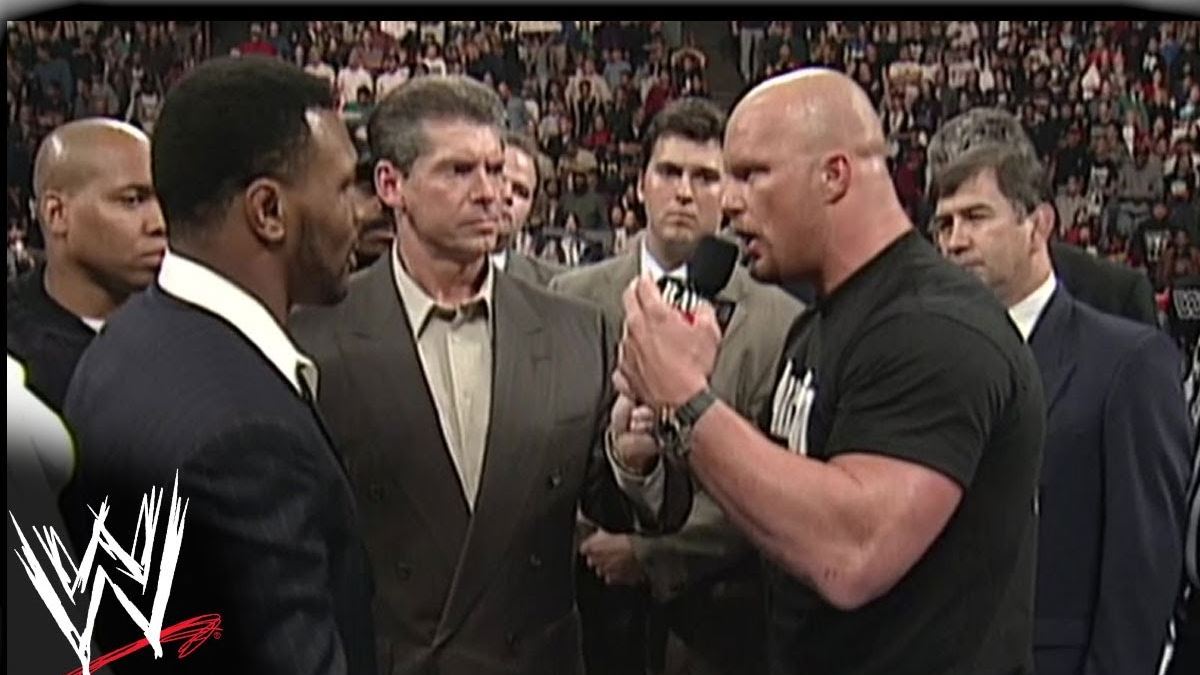
Austin infamously aggravated boxer Mike Tyson leading up to WrestleMania 14 where Tyson was the special ring enforcer for the championship match between Austin and Shawn Michaels.
Slam: Well, to be fair Vince was in a way your boss too.
McAvennie: Yes, he was. I wouldn’t dare try to beat him up! I’ll tell you, what is he 75, 76 years old now? He’s phenomenally strong. He would kick my ass in a minute. He is a hardcore gym rat. The guy works out to no end still. And I can attest to that. Because I could hear him blaring AC/DC music in the gym in Stamford, which was right next to our office going on at 10:30 at night, 11 o’clock at night while we’re working on RAW or Smackdown.
(Back to Austin moments) I also loved the WrestleMania 13 match (against Bret Hart). I love the fact that he never tapped out that he just passed out. I just thought that was a phenomenal match. Because it really solidified how awesome a character that Stone Cold Steve Austin was, and that he wasn’t going to win every battle. But he was never just going to give up. Or he was never going to just lie there and take his beating. He was going to fight you tooth and nail all the way. What particularly worked for me about that was on the same night that Stone Cold emerged as an antihero, Bret Hart went from hero to villain with the same moves and he didn’t necessarily do anything different. Other than maybe he would give a longer look after after the fact when people were booing him for it. Or he would give that look to Ken Shamrock (the special guest referee for the match) when Shamrock pulled him off Stone Cold. I just thought the storytelling in that was phenomenal. And Austin and Bret Hart both deserve a lot of praise for it. That’s something that couldn’t really happen if it’s rehearsed too much. It was clear that these guys kind of went off script. And that’s something else I bring up in the book too. At the time, there was a no blood policy in the matches. And naturally, when Stone Cold bled, WWE management wasn’t thrilled. But they couldn’t argue with the results, because it’s what put Steve Austin on the map. It’s something that really helped to put WWE on the map then. So I’m sure they were forgiving about it.
There’s so many moments! I know everybody brings up the beer truck and the Zamboni. Those are all great moments. I enjoy them immensely. But for me, I just loved it whenever Austin was in the ring and had a microphone in his hand. Because that to me, there were no gimmicks. The thing was either going to succeed or fail, based on what he said in the ring. And he had my attention at all times. And that’s a lost art. The ability to command respect, or one’s attention, just from uttering words, it’s a lost art in society these days in a society filled with mobile devices and tablets and YouTube and whatnot. So I thought that was amazing stuff. And there was one other promo and I know that a lot of people probably think it stunk, but I don’t. In 2020, for Austin 3:16 Day, they had Stone Cold on RAW. And that weekend, the pandemic had officially shut everything down. So Austin came out, and he did the whole chant with the audience, but the audience wasn’t there. And he’s like, ‘If you want to see Stone Cold, celebrate 3:16, give me a hell yeah.’ And then just cuts to the seats in the crowd. And there’s nobody there. I just thought that was great. Because again, this was something that yeah, it could have gone over like a fart in church. But he had my attention, and he sold it, he made it work. And that’s something most guys can’t do. And that’s not a knock on anyone else. It’s a testament to Austin’s ability to speak on a microphone.
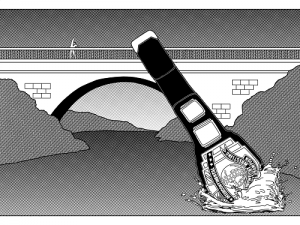
On December 15, 1997, Austin forfeited the Intercontinental title to the Rock by tossing it over the General Sullivan Bridge and into the Piscataqua River. Illustration by Anthony Ruttgaizer.
Slam: Why didn’t you end the book with Steve’s infamous phrase: “And that’s the bottom line because Stone Cold said so?”
McAvennie: Because I say it so many times in the book already. Honestly! He says it a ton. And I could have done that. But the thing is, he actually says it in the very beginning too. And this was something that I think was asked of me also on the Busted Open podcast. He asked why didn’t I go linear with with the book? Well, the reason was that I started my outline thinking that I’d try and go linear. But I have to tell you, when I did it that way, it sucked. It just did not work for me. And the reason why I thought that was not because the facts weren’t interesting or anything, but it’s just do people want to read 30 pages of Stone Cold growing up before they get to the good stuff of him being in the ring as Stunning Steve Austin, or as a Hollywood blonde, or his time in ECW (Extreme Championship Wrestling) moving on to WWE? No, they want some of that stuff upfront. If you don’t grab people’s attention at the beginning of a book, usually they’re not going to make it to the end of the book. And I wanted to make sure that we had people’s attention throughout. So I peppered the dates and covered different dates in and jumped back and forth in time to really kind of make sure that people were sampling all aspects of Steve Austin throughout his career and in elements of his life.
Slam: What was it like working with Anthony Ruttgaizer for the art in the book?
McAvennie: I didn’t know Anthony at the time. I knew the book was going to feature illustrations, but I never actually worked in tandem with him. The illustrations came after the book had been written.
Slam: So did you give him suggestions? Or was he kind of on his own?
McAvennie: I threw a few suggestions over to Michael Holmes, the editor. But also having been an editor for both book publishing and websites and comics, I also want to respect the editorial process too. If the editor asked my opinion, I’m glad to weigh in and give them an opinion because I’m not shy. But I also want the editor to be able to flex their muscles and say, ‘Hey, this is what I think is going to be right for the book.’ So I threw a few suggestions here and there. But Michael steered that ship. And I thought Anthony did a great job.
Slam: What did you think when you first saw the illustrations?
McAvennie: I was surprised. I wasn’t sure what to expect. I saw them in a final proof. And I think I only had one or two slight edits about the use of blacks and shading in some areas because they’re black and white illustrations. But overall, I thought he did a phenomenal job. He was terrific. And he’s been nothing but a kind, gracious person touting the book on social media. So full props to him. I think he did a great job and I hope that I find an opportunity to work with him again down the road.
Slam: Why did you decide to go with illustrations instead of photos?
McAvennie: To be honest, I didn’t. I didn’t choose that. That was something that the team at ECW Press and WWE had agreed to. I think there were several considerations brought into it. Of course, there’s always budget to consider. They wanted to make it an easy, affordable book. So it was probably easier to go with a few illustrations then to provide tons of photos printed in color. So I think that there were elements of that. But I also think it was a timing issue, too. There were not a lot of hands working on this book. So I think that Michael and Steve (Pantaleo) in WWE thought illustrations would probably provide a little bit of a different visual. But also provides something familiar for people to appreciate. So I thought it was a good move, I thought it was different. I think photos are naturally an easy solution. It’s just a matter of them picking the best photos and I think photos also have to go through a pretty extensive approval process. And that’s something that we may not have had the luxury for and the time for, with time constraints being what they were.
Slam: What do you want readers to take away from the book?
McAvennie: A few things that I would like readers to take away from the book, I hope that readers look at this and celebrate moments that they either remember from their childhood, or are only catching up with now on WWE Network about a very charismatic, strong willed individual, like Stone Cold Steve Austin. I hope that they take into account that there’s more to who came up with the character. There were a lot of pieces and a lot of players in the evolution of Stone Cold Steve Austin, sometimes for the better, sometimes not. It’s sort of like growing pains. Steve came in as the Ringmaster, that didn’t work. He had a few names thrown his way when he came up with the ice-cold type of persona. And those didn’t work, but it was his ex-wife (Jeanie Clarke) who came up with the name. She just told him to drink his tea before it got stone cold. Those are little accidents that define a character and that I find to be amazing. I find it to be amazing and very interesting. And I hope readers do too. I also think that if people are looking at or reading the book, they’re also seeing that Austin is a guy who has very definitive opinions about his persona and about the WWE brand. And you know, whether you agree with them or not, I think that it’s something that if he hadn’t had such a strong will, and if he didn’t draw those lines in the sand where he thought they were needed to be drawn, I think we would have gotten a very different character and one that Stone Cold might not have cared for and maybe the fans might not have cared for as much. So I want people to appreciate that.
Even though there was a lot of collaboration into the Stone Cold persona, Austin really did come up with a lot of it on his own, because he was basically providing an extension of himself. And I also think that he’s a very intelligent person. I don’t think he gets a lot of credit for that because he came in (to pro wrestling) as a well, he was known as a brawler type of superstar. And towards the end of his run, he was actually a very, very good technical wrestler back in the day in WCW (World Championship Wrestling) before his injuries and everything took over. But he was very smart. I mean he almost finished college. He only had about 17 hours to go and he just couldn’t afford to keep going. He needed to work. So he opted out. And that worked out for him. But he’s a guy who knows a lot of different things. He knows a lot about the outside world. He knows a lot about what people like. And I think that resonates with people. He reaches them in a way that a lot of us aren’t necessarily as gifted at. By that I mean, he knows at least in terms of his in ring exploits, he knew when something was going to go well with the fans. He also knew when he turned turned heel, back in 2001, he knew right away as soon as he shook Mr. McMahon’s hand, he knew right away that something was off, it didn’t work. He liked that they were trying to do something different with his character and to help refresh him. But he knew that it wasn’t genuine. Fans were still cheering him. He couldn’t get them to stop cheering him no matter what he did. And I think that, to his credit, he saw that and I think he would vocalize that with with management. And they would realize at some point that no matter what we’re going to do, people love Stone Cold. Let’s just get him back in the fold and be the good guy again. So I think that that takes a lot of intuitiveness and intelligence that I think very, very select few sports entertainers have.
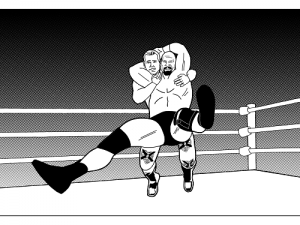
Austin delivers a Stone Cold stunner. Illustration by Anthony Ruttgaizer.
Slam: What is next for you and will pro wrestling be a part of that?
McAvennie: I’m not sure to be honest. I think pro wrestling is always going to be there for me in some some capacity. I still will do some projects here or there for WWE. With regards to what I’m doing next, honestly, I’m really just enjoying the moment. I work full time with Peak (a men’s wellness site), I am a content director there. But on the side, I like to write projects like this Stone Cold book. And hopefully I’ll be doing that again very soon. I’m talking to WWE about some possible ideas down the road and we’ll see how it goes.
EDITOR’S NOTE: This conversation has been edited for clarity and length.
RELATED LINKS
- Buy Austin 3:16: 316 Facts and Stories About Stone Cold Steve Austin on Amazon.ca or Amazon.com
- Michael McAvennie: Facebook * Twitter * Instagram
- Anthony Ruttgaizer: Website * Twitter
- ECW Press: Website
- SlamWrestling Master Book List
PREVIOUS STEVE AUSTIN STORIES
